Marguerite Santreuil
Previously on this blog, I’ve covered the earliest known gramophone records in Esperanto and the first 12-inch Esperanto LP. Today’s post looks the first vinyl release in the language: a 7-inch 45rpm EP from 1957, simply entitled Esperanto.
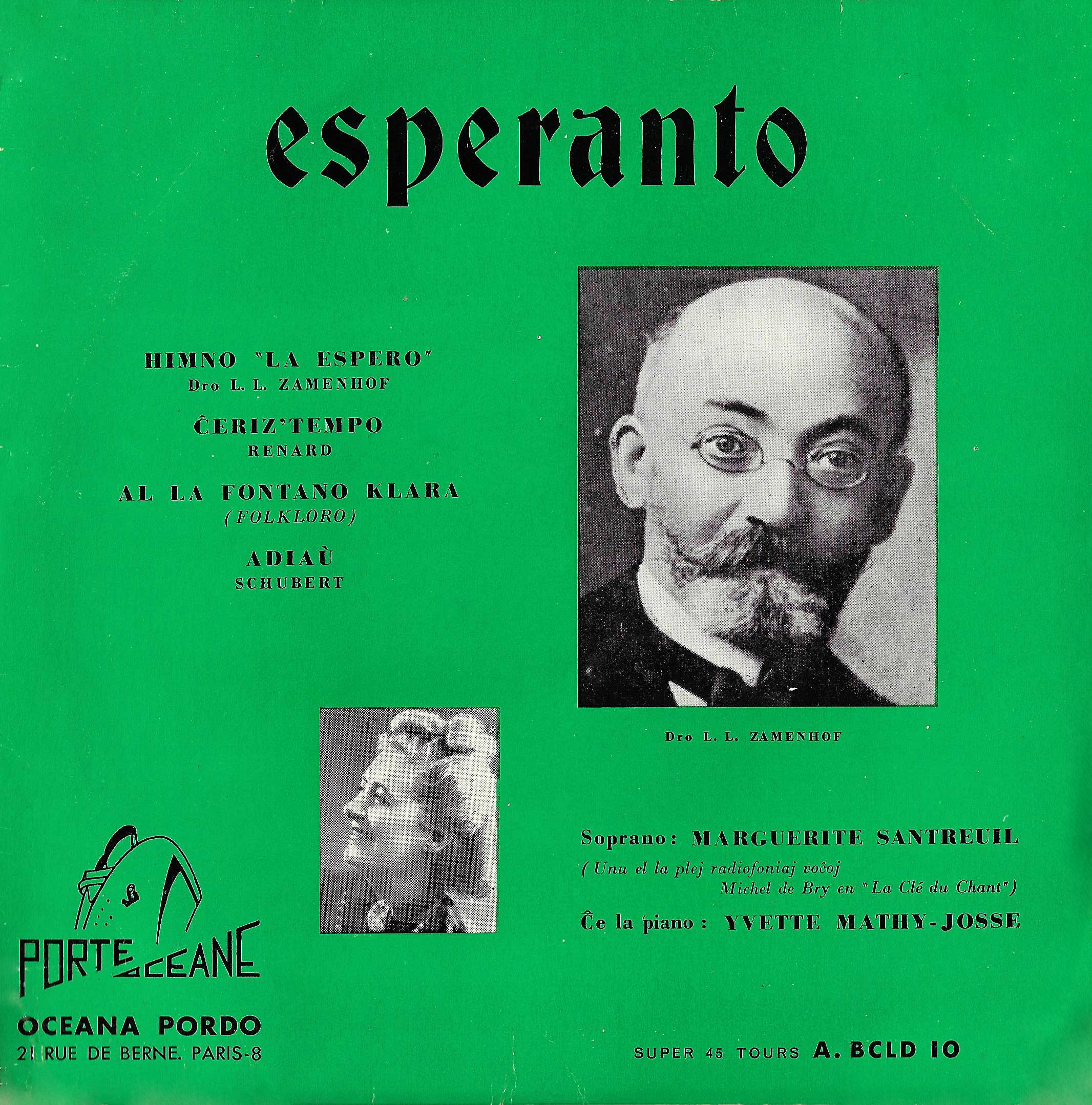
The EP contains four songs performed by Marguerite Santreuil (soprano) with Yvette Mathy-Josse on the piano. The first track is, naturally, the Esperanto anthem La Espero, and is followed by three songs translated from French.
Ĉeriz-Tempo (Le Temps des cerises) was written in the 1860s by Jean Baptiste Clément and Antoine Renard. The song is very well known in French-speaking countries, and is particularly associated with the Paris Commune of 1871. The French Wikipedia describes it as “one of the most recorded songs in France, if not the most recorded”, and gives dozens of examples, dating from the era of cylinder records to the present.
Al la Fontano Klara (À la claire fontaine) is listed as a “Canadian folk song”, and is particularly popular in Quebec and the Maritime provinces, but also with known versions from France and Belgium. Like many folk songs, just about every source I looked at has a different story about where and when it was written.
Adiaŭ (Adieu) is a song by the Austrian composer August Heinrich von Weyrauch, although it is frequently misattributed (including on this record) to Franz Schubert. Originally published with German lyrics under the title Nach Osten, its French lyrics and misattribution were both provided by an 1840 publication by a Mr Bélanger.
The liner notes describe how Marguerite Santreuil “sings and pronounces the words most correctly”, and that there was no need to introduce her, as “you have already heard her on stage, in recitals and on the airwaves in over 40 countries”. This last statement is no doubt influenced by the fact that the record was released on Marguerite Santreuil’s own record label, Porte Océane, or Oceana Pordo in Esperanto.
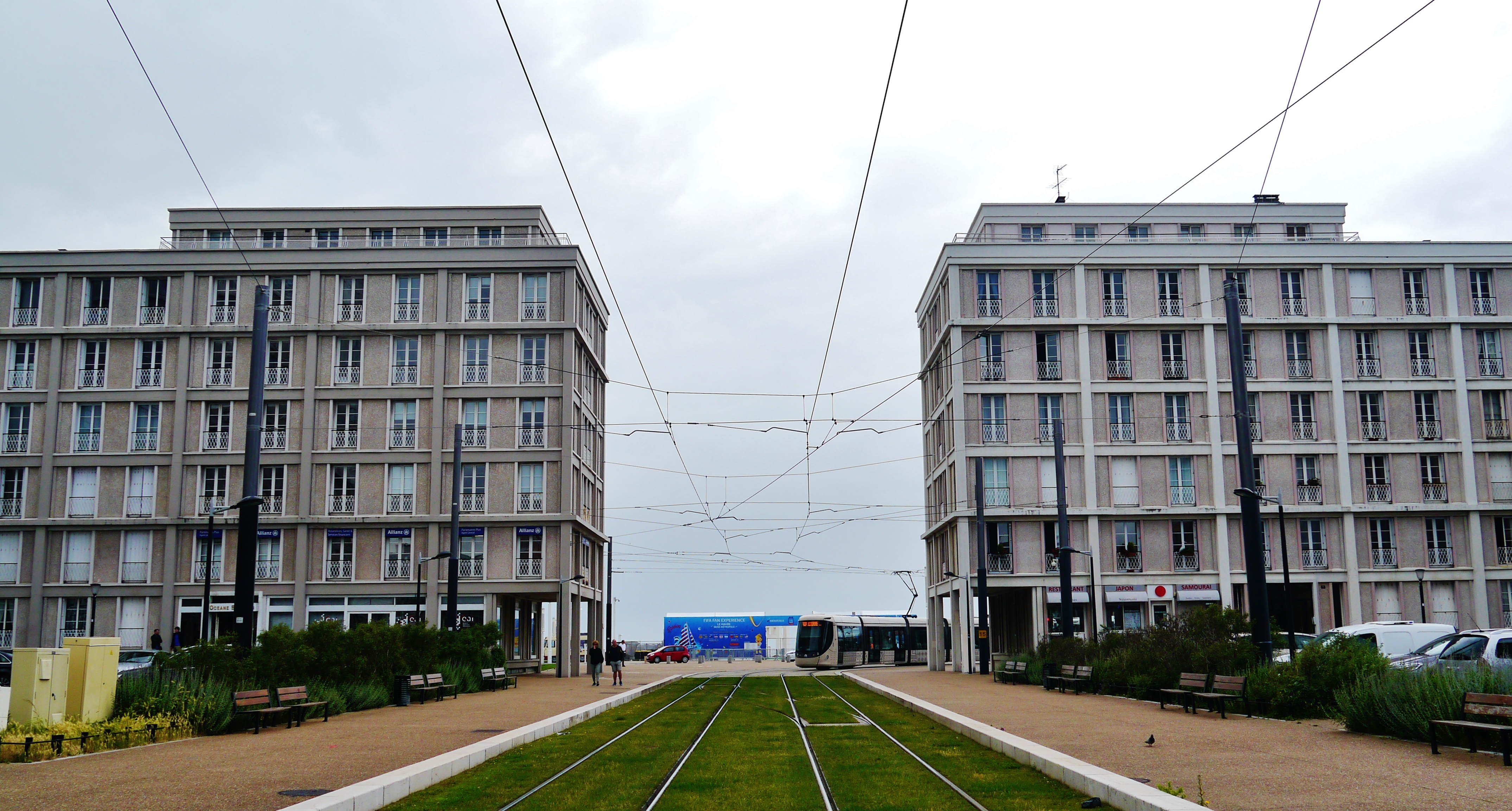
The Porte Océane in Le Havre, pictured in 2019. The tramway is a more recent addition; when the buildings were completed, this would have been an ordinary road. (Zairon / Wikimedia Commons; CC by-sa 4.0)
The label is presumably named after the landmark of the same name in Santreuil’s home town of Le Havre: twin modernist buildings constructed in the 1950s, flanking the main road from the town to the seafront, built as a symbol of the town’s reconstruction following the Second World War. This implies that Esperanto was a fairly early release for the label: as the buildings were completed in 1956, it is unlikely that the label could have been founded before that date, and this record was released in 1957. The back cover advertises four other records by Marguerite Santreuil and her pianist Yvette Mathy-Josse, all in French.
The Laŭjara katalogo de muzikaj diskoj en Esperanto reproduces the below advert for the Esperanto EP from the monthly magazine La Praktiko in July-August 1957.
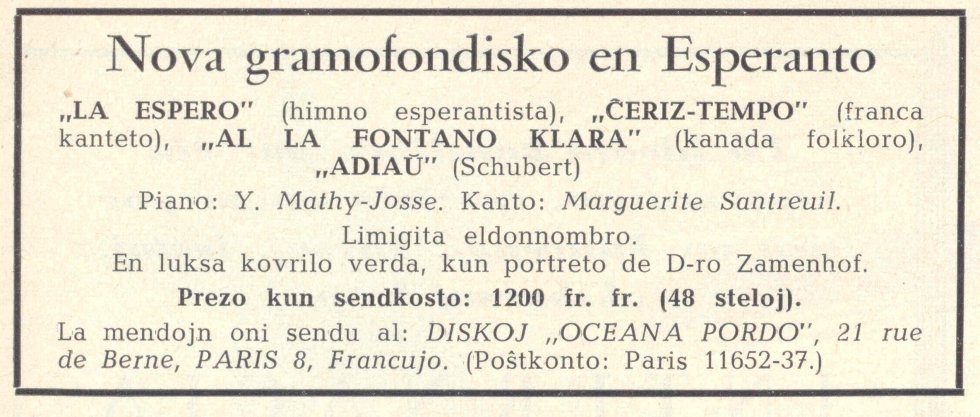
The price of 1200 “old” French francs (the currency was revalued in 1960, with one new franc being worth 100 old francs) is equivalent to about €28 in modern money. The price is also quoted in steloj - an alternative monetary unit used by some in the Esperanto movement in the 20th century, especially for international transactions. One stelo was originally worth 0.25 Dutch guilders, and was intended to be fixed at the price of a standard loaf of bread. Unfortunately I wasn’t able to find the equivalent prices of non-Esperanto records in France in 1957, but newspaper adverts from the UK show that a 7-inch 45rpm EP retailed for between 11 and 12 shillings, which is equivalent to about £12 or €14 in 2025.
Perhaps a better way to compare the two prices is to look at the historical exchange rates in 1957. This is not as simple as it sounds, as the rates given by different sources vary: one source implies that 1200 old francs were worth about £1 3s 7d, while another source suggests about £1 11s 2d. Even this, however, doesn’t take into account the fact that the same goods could be priced quite differently in different countries, nor the fact that the price quoted in the advert includes international postage, which obviously adds a significant premium over the price of a record from a local shop. Nonetheless, it does still suggest that Esperanto was significantly more expensive than a typical EP of the period.
The “deluxe green cover” mentioned in the advert is simply an ordinary cardboard picture sleeve. This was not yet necessarily the standard packaging for EPs in 1957; many would have been supplied in generic paper sleeves. Amusingly, although the cover features pictures of both Marguerite Santreuil, as the artist featured on the record, and L L Zamenhof, creator of Esperanto, it is the latter that is the larger and more prominent!
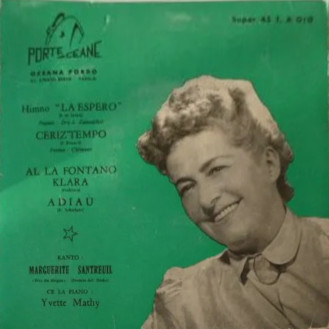
The advert and liner notes both state that the record was produced in a limited quantity, although it seems that there were at least two editions of the record published in different covers. The cover art shown here was originally uploaded to Discogs, and features Marguerite Santreuil much more prominently, without the portrait of Zamenhof. I suspect that this cover was used to sell the record to Santreuil’s French-speaking fans, and the Zamenhof cover was for the international Esperanto community, as the latter must be the edition referred to in the advert.
Esperanto was not Marguerite Santreuil’s first record in the language. She had previously recorded La Espero as a 78, and Discogs knows of another 78 on the Sonabel label in which Santreuil sings Malgajeco - Chopin’s Étude Op. 10 No. 3 ("Tristesse") with lyrics by Raymond Schwartz, who himself sings Nenio kaj Io ("Quelque chose et rien" by Paul Delmet) as the B side. Schwartz is best known in Esperanto circles as an author, and as the lyricist of the song Ĉiu, Ĉiu, which was published in 1948 and was one of the most popular Esperanto songs in the communal singing era. It can be heard on Ni Kantu en Esperanto and on the Londona Esperanto-Ĥoro’s 1983 album Londono Kantas.
Discogs suggests that the Sonabel 78 was released circa 1933, presumably based on the catalogue number and the other known releases on the label all being from that era. However, a notice in the Heroldo de Esperanto of 15th September 1947 describes the disc as “new”, adding that copies had been sent to radio stations in various cities and asking listeners to request it. The date of 1947 is more consistent with both Santreuil’s and Schwartz’s known musical careers - it would be surprising for them to have made a record in the early 1930s and then not to have published anything else until the late 1940s. It is also consistent with the date of a 1948 concert tour mentioned in Stanislav Kamarýt’s Historio de la Esperanto-movado en Ĉeĥoslovakio, in which Santreuil performed a programme of arias and songs in Esperanto and French, with dates in 11 Czechoslovak cities and performances on three radio stations.
While it’s likely that Marguerite Santreuil made other recordings in Esperanto, and certainly gave many other concerts in the language, I haven’t been able to find any further details of them. Nonetheless, it seems safe to say that she was active as an Esperanto singer from at least the late 1940s until the late 1950s.
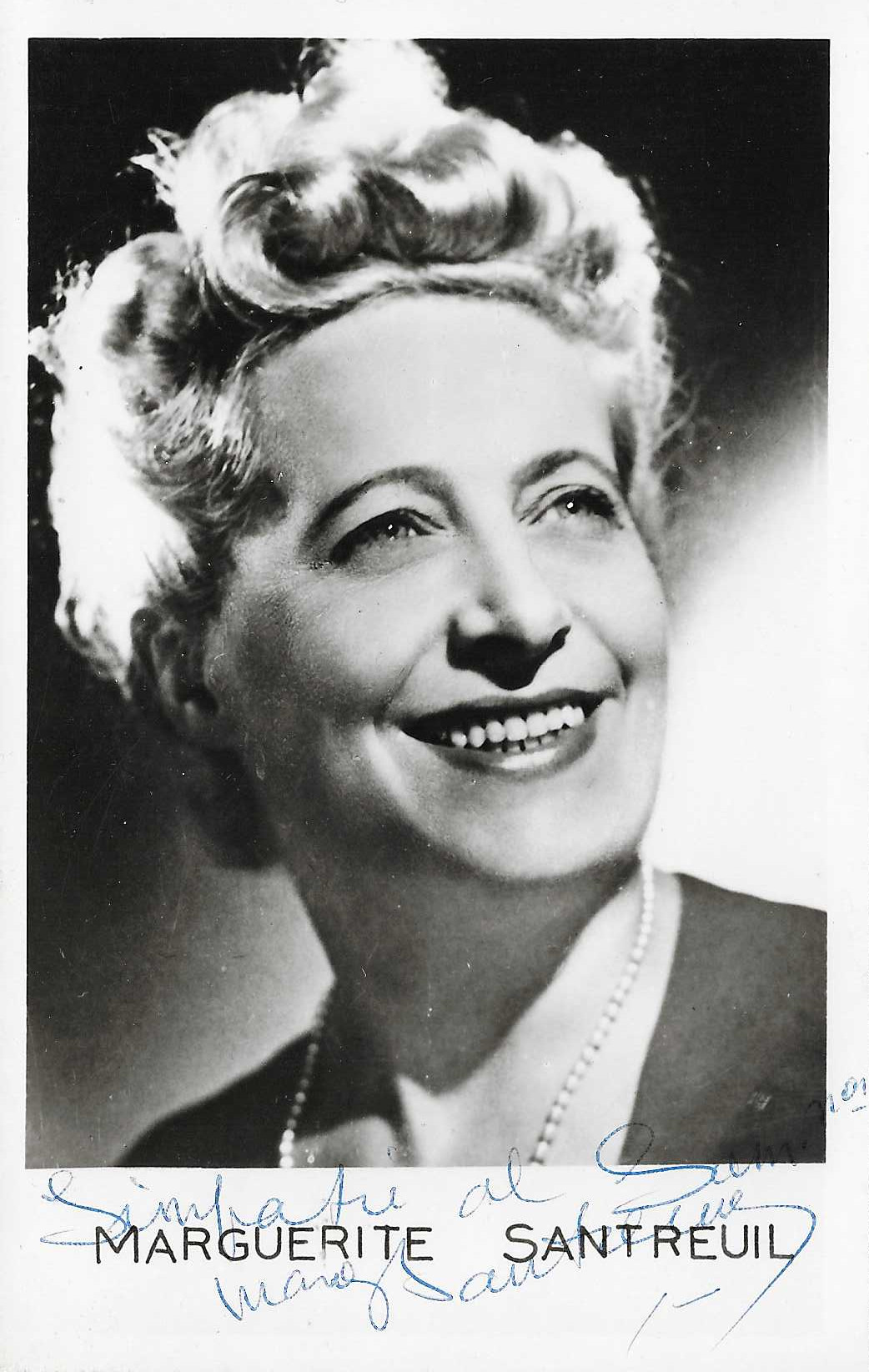
An interview in the Paris Normandie newspaper with her son Henri, published in 2021, gives more detail about her life and career. In fact her surname was not Santreuil but Sautreuil - it seems that her name was mis-transcribed on the label of one of her earliest records, and rather than correct it she adopted the misspelling as a stage name. My copy of the Esperanto record came with this signed photograph of the singer, with the printed caption Marguerite Santreuil and the signature clearly reading Marg Sautreuil!
Marguerite Sautreuil first became aware of Esperanto when she met Lidia Zamenhof, daughter of the language’s creator L L Zamenhof, at Le Havre. Henri Sautreuil believes this to have been in 1938 or 1939, but Wendy Heller’s biography of Lidia Zamenhof shows that her time in Le Havre was in the winter of 1935-36, when she taught three Esperanto courses. Presumably this is how Marguerite Sautreuil learned Esperanto, although her son simply mentions that she helped with the organisation of the courses. Professionally, she was a shorthand typing teacher, but was always very passionate about music, having studied with Nelly Martyl, soprano for the Paris Opera.
Marguerite Sautreuil’s recording of La Espero was included in a 2013 compilation, L’Esprit Anarchiste 1820-1990. This is the same recording as on the Esperanto EP, and is the first time that her performance was credited to her under the correct spelling of her surname.
Discography
Marguerite Santrueil also made many recordings in French. Only records with Esperanto lyrics are included here.
- Malgajeco (78 - Sonabel 12205, with “Nenio kaj Io” by Raymond Schwartz)
- La Espero (78 - label, catalogue number and B-side unknown)
- Esperanto (45 EP - Porte Océane BCLD 010)
- L’Esprit Anarchiste 1820-1990 (2 CD compliation) - La Espero / L’espoir (Hymne)
Sources
- Quell Havraise a enregistré l’hymne espérantiste ? - Paris Normandie, 18 July 2021
- Laŭjara katalogo de muzikaj diskoj en Esperanto
- Kamarýt, Stanislav. Historio de la Esperanto-movado en Ĉeĥoslovakio - 5.25.2. Teatraj kaj koncertaj prezentadoj
- Heller, Wendy. Lidia: The Life of Lidia Zamenhof, Daughter of Esperanto. Page 136
- Heroldo de Esperanto, 15 September 1947. Page 4: “Novan Esperanto-diskon”
Comments
Comments are welcome in any language, especially Esperanto.
All comments are moderated before publication.
Komentoj estas bonvenoj en ĉiuj lingvoj, aparte en Esperanto.
Ĉiuj komentoj estos kontrolitaj antaŭ publikigo.